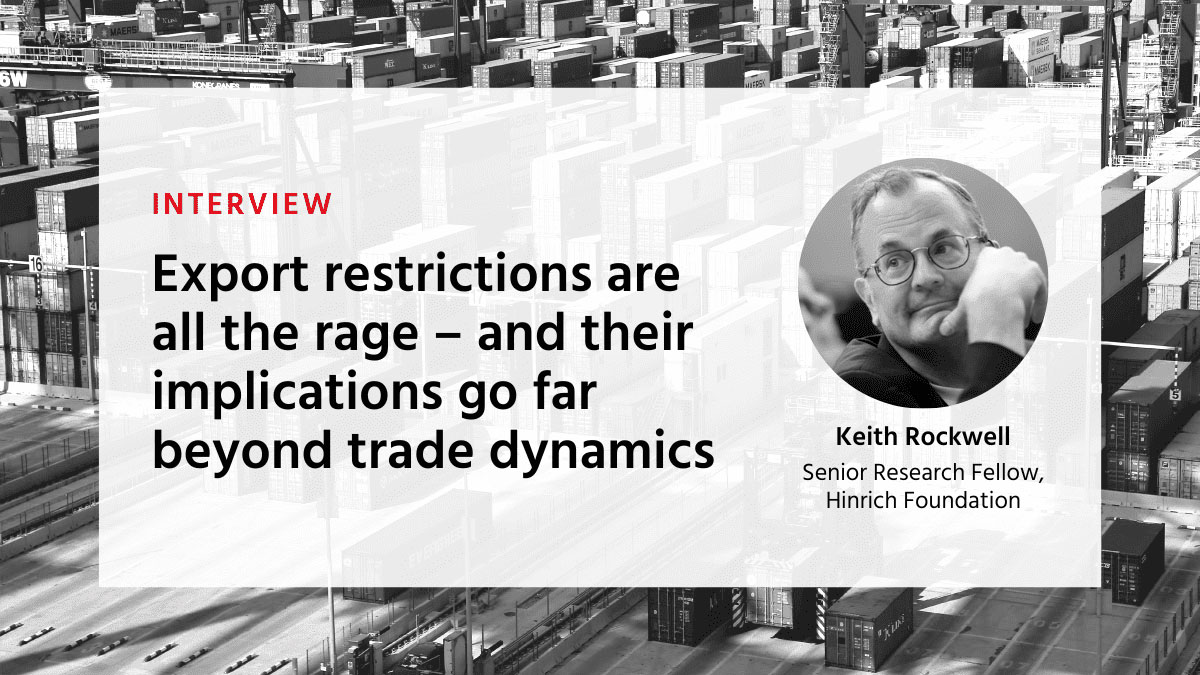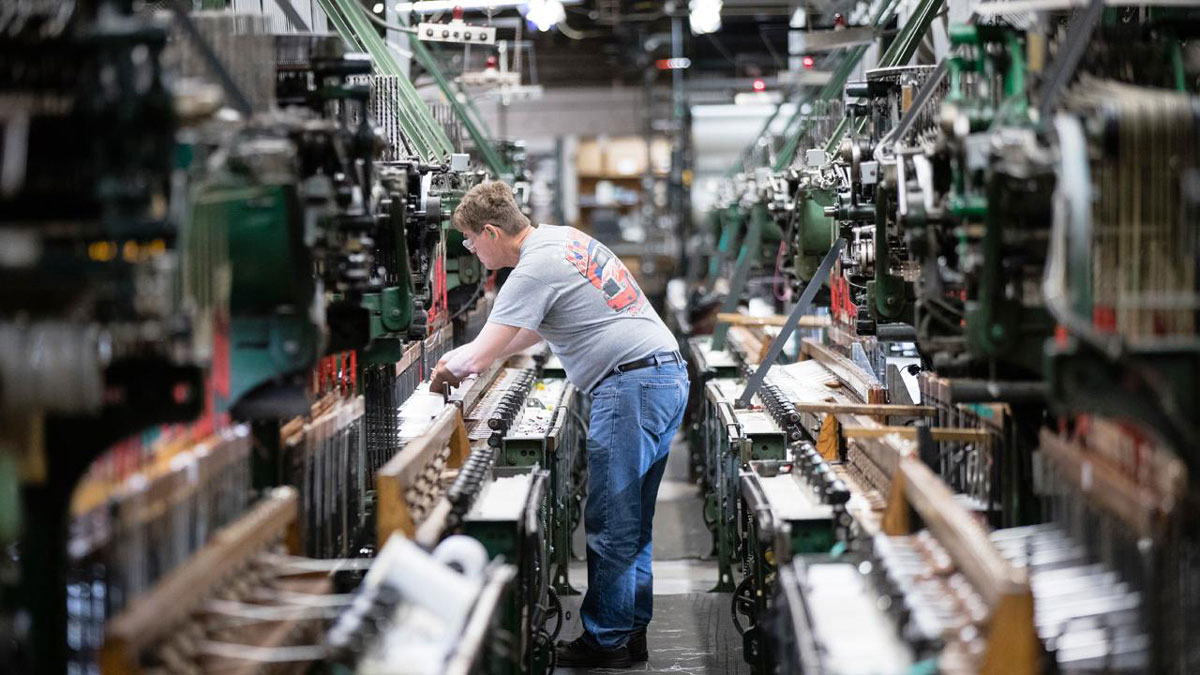Keith Rockwell, Senior Research Fellow at the Hinrich Foundation and former Director at the World Trade Organization (WTO), brings a wealth of experience and insights into the complex world of international trade. In a recent discussion with the Association of Foreign Press Correspondents (AFPC-USA), he offered valuable perspectives on the growing trend of export restrictions, a topic that has gained significant prominence in recent years. These restrictions, driven by various factors and crises, have become a tool used by governments to protect their interests, national security, and domestic populations. Their implications extend far beyond trade dynamics, affecting issues like global health, climate change, and geopolitical relations.
Rockwell highlights that export restrictions, often imposed as a response to crises, can vary widely in their scope and motivations. From the limiting of COVID vaccine exports during the pandemic to curbing sales of food supplies after the outbreak of the war in Ukraine, governments have justified these actions as necessary to ensure their citizens' well-being.
However, the use of export restrictions is not confined to times of crisis. "National security" has emerged as a common rationale for curbing exports. Rockwell notes that this notion of national security can be interpreted in diverse ways, from restricting high technology exports to safeguarding critical raw materials. Notably, both the United States and China have employed this justification in their export restrictions—though of course the larger picture is more complicated than that.
Rockwell's insights paint a comprehensive picture of the complex motivations behind export restrictions, their diverse consequences, and the global trade landscape's uncertain future.
The following interview has been condensed and edited for clarity.
Can you elaborate on the trend of governments increasing their implementation of export restrictions in recent years, particularly since 2020? What are the key factors driving this trend?
There are many reasons why governments have resorted to the use of export restrictions but there is one driving force behind the imposition of many of these measures—a response to a crisis.
In restricting exports of COVID vaccines during the pandemic, or curbing sales overseas of grains and other foodstuffs since the outbreak of the war in Ukraine, governments believed this was necessary to preserve supplies for their own citizens.
More broadly, governments have fallen back on the need to preserve “national security” as a reason to constrain exports. National security can be defined in different ways, but the US has invoked this in its restrictions on the export of high technology to China, the Chinese have done the same in restricting export of rare earths and other critical raw materials.
Then we have seen some developing countries limiting or banning the export of raw materials in a bid to prod foreign extractors of these materials to establish processing or production facilities in the host country. The idea is that this would encourage new facilities and lead to job creation through value added processing of raw materials. This has worked well in Indonesia, less well, at least so far, in other countries.
How do these export restrictions compare to traditional trade barriers like tariffs and quotas in terms of their impact on global commerce?
They are actually more protectionist and more dangerous. Tariffs and quotas are designed to protect narrow sectors of the economy, say steel or auto producers, and the negative consequences of these actions are equally narrow—adversely impacting foreign producers of those products but few others beyond this.
Export restrictions—of medicines or food—are designed to protect entire populations and the consequences for other countries are far more profound than would be the case with import tariffs or quotas. Africans have paid a very heavy price for vaccine export bans imposed by the United States, the European Union and India. Africans and others have also paid for restrictions on exports of grains, other foodstuffs and fertilizers.
What types of products and industries are most commonly affected by these export restrictions? Are there specific examples that highlight the breadth of these measures?
Medicines and other health related products, food, raw materials, rare earths and technologies deemed to be “dual use” i.e. they may have military as well as civilian applications. Whatever form they assume, these restrictions are on the rise. From 2015 to 2019, the average number of export restrictions applied by World Trade Organization members each year was just under 24. Since 2020, the annual average has more than tripled to 77.6 per year. The last two years saw by far the largest number of export restrictions, and the majority of these were quotas or bans. According to the WTO, 58 such restrictions were implemented between mid-October 2022 to mid-May 2023, hitting US$45.7 billion in exports. During the previous six-month period, US$114.5 billion in exports were similarly restricted.
Could you provide more details on the economic consequences of these restrictions, both in terms of supply chain disruptions and broader geopolitical implications?
For example, during the pandemic export restrictions severely limited access to lifesaving COVID vaccines, masks, ventilators, and other medical products for patients in developing countries. The panic induced by the war in Ukraine disrupted trade in food and fertilizers, as governments overreacted to make sure domestic needs were met first. State-imposed limits on the export of strategic minerals has sent other governments scrambling to find new sources of these materials which are so vital in the production of renewable energy products, including electric batteries for automobiles, solar panels, and wind turbines.
You mentioned that the rationale for export restrictions varies among economies. Could you delve deeper into these motivations? What are the common justifications given for imposing these restrictions?
The principal driver of policies linked to export restrictions is crisis. The world has been hit by a series of catastrophic events over the past 15 years—the global financial crisis, the pandemic, the US-China clash, the war in Ukraine—all of which have pushed governments into nationalist positions on matters of the economy.
Superimpose over this the burgeoning superpower rivalry in which China and the United States are engaged in a rapidly escalating geoeconomic conflict and the result is a sharp rise in restrictions on the export of technology—goods, services, and capital. Perhaps this conflict germinated in Beijing, which over the past decade has reverted to restrictions on the export of raw materials and rare earth minerals, but the Biden administration has not stood pat. Washington has come up with new ways to curb the flow of US technology— merchandise and services—and is now targeting capital flows.
How do national security concerns factor into the decision to impose export restrictions, and can you provide specific examples of how these concerns have been cited by governments?
National security is the oft-cited reason for imposing restrictions on exports. Following the global financial crisis, China’s unprecedented economic rise, the sharp turn in US policy against trade, the pandemic, and then the war in Ukraine, governments have adopted increasingly nationalistic trade policies aimed at keeping vital goods, services, and capital within their borders. The national self-interest argument is clear-cut when it comes to hoarding food and medicines. Other national security elements are less obvious. Limits on technology exports might be based on the need to curb a rival country’s military development but other times the motivation is purely to retain, or augment, a technological advantage for geoeconomic reasons.
How have export restrictions impacted the global response to critical issues like the COVID pandemic and climate change mitigation efforts? Are there specific instances where these restrictions have hindered progress in these areas?
Although the rapid development of the COVID vaccine was justly celebrated around the world, these celebrations were tempered by the obvious fact that distribution of the vaccines was far from equitable. Although many activists blamed this on patent holders in the developed world, the inescapable fact is that export restrictions were the real reason behind the immediate lack of access to vaccines for people in the developing world. These restrictions applied not only to COVID vaccines but to masks, ventilators, and other medical products needed for the treatment of COVID.
These restrictions were ill-conceived. Trade is the means through which lifesaving products move from countries of surplus to countries of shortage. There is also a strong moral argument to be made against depriving patients in the developing world of the drugs they need to stay alive.
Another reason these restrictions were a bad idea is that the vaccines themselves could not be produced without trade. The Pfizer-BioNTech vaccine is made up of 286 materials supplied by 86 companies located in 19 different countries. AstraZeneca’s vaccine is produced with inputs from 20 suppliers based in more than 15 countries. Curbing trade in these products is self-defeating. And yet, as the WTO points out, governments put in place 174 export restrictions since the start of the pandemic. While 152 of these measures have been repealed, 22 remain in place.
When the war in Ukraine began in February 2022, government curbs on exports of essential products quickly led to global shortages of food and fertilizers. These shortages provoked widespread anxiety in capitals about how to secure adequate supplies. From mid-October 2021 to mid-October 2022, WTO members applied 72 export-restrictive measures which affected US$110 billion in exports. 52 measures covering US$56.6 billion in exports remain in place today. Before the war, Ukraine and Russia accounted for about 30% of global wheat exports. When those supplies were embargoed, a domino effect ensued as other countries sought to preserve their own food supplies.
You mentioned resource-rich developing countries imposing export restrictions. Could you provide examples of how these restrictions have influenced investment patterns and value-added production in these countries?
Resource-rich developing countries, frustrated by decades of sourcing raw materials for rich countries only to be shut out of value-added production and processing have implemented export curbs to encourage producers from wealthier countries to invest in job-creating facilities at the source of these materials.
This trend is particularly evident when it comes to so-called critical raw materials like nickel, lithium, cobalt, manganese, and rare earth minerals. These materials are vital in the production of electric vehicles—and especially the batteries that power them—as well as solar panels, wind turbines, advanced semiconductors, and other environmental goods.
As governments spend hundreds of billions to combat climate change, demand for these materials has surged. But the extraction, production, and processing of these materials rest in the hands of very few countries. According to the Organisation for Economic Co-operation and Development (OECD), the hoarding of these materials has risen five-fold in the last decade and today, 10 percent of global trade in critical raw materials is hampered by at least one export restriction measure. Export taxes, which are allowable under WTO rules, are the principal tool of choice.
Many developing countries rightly say that the extraction companies, mainly Chinese but also Western, have failed to invest in the local processing and production needed to create more and better jobs. Such concerns induced governments in Zimbabwe and Namibia to ban exports of raw lithium. The Chilean government has expanded its role in managing two large lithium mines and is considering nationalizing them when contracts with foreign mining concerns expire.
These governments are following the example of Indonesia, which has had some success in using export restrictions to prompt broader foreign investment. Since Jakarta’s 2014 export ban on nickel ore, foreign investment has skyrocketed —more than US$15 billion in nickel processing alone. Large multinational companies like Ford, Vale, China’s Zhejiang Huayou Cobalt Co. and Hyundai are racing to set up shop in the archipelago.
But such policies can have unintended consequences. Restrictions imposed by Zimbabwe and Namibia may encourage other lithium producers like Ghana and Namibia to increase their presence in the market. Indonesia’s efforts to induce Tesla to build electric cars in the country have thus far foundered. Jakarta’s bans on the export of nickel and bauxite have also angered trading partners. The European Union has already won a dispute settlement case against Indonesia in the WTO. The Biden administration has to date rebuffed Jakarta’s requests to negotiate a bilateral strategic materials trade agreement.
Do such restrictions work? Not always. According to a 2017 OECD study of export controls in four African countries export restrictions did little to generate new processing or production investment. Instead, these measures hindered export sales and undermined the competitiveness of domestic raw material producers. In no case did the implementation of the restrictions lead to improved export performance of downstream processors. The reason: A lack of adequate transportation and power infrastructure, shortages of capital and skilled workers, and poor government administration of the policies.
What are the potential future trends in terms of export restrictions, and how might they evolve in response to changing geopolitical dynamics?
There is no indication that the factors that have driven economic nationalism—the rise of populism, geopolitical tensions, climate change, armed conflict—are going away any time soon. To the contrary the global economy is becoming ever more fragmented. Global rules are being flouted by all the major economies and the prospect of major reform at international organizations is depressingly remote. Given this it seems very likely that governments will continue to revert to export controls of goods and technologies for the foreseeable future.
***
This article was first published by ForeignPress.org.
© The Hinrich Foundation. See our website Terms and conditions for our copyright and reprint policy. All statements of fact and the views, conclusions and recommendations expressed in this publication are the sole responsibility of the author(s).












